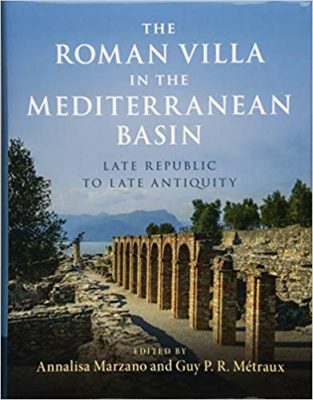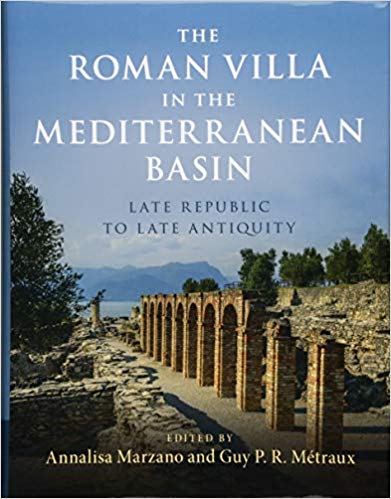 Editors: Annalisa Marzano and Guy P.R. Metraux
Editors: Annalisa Marzano and Guy P.R. Metraux
Publisher: Cambridge University Press – 599 pages
Book Review by: Sonu Chandiram
This book is about the expansion and proliferation of Roam villas into the Mediterranean under Roman hegemony is the subject of this book.
Villas were extra-urban (outside of population centers such as a city) suburban, or seaside country houses. Many were with productive estates such as agricultural lands contiguous or non-adjacent to them. But some were purely residential, and these were unmistakably signs of high Roman socioeconomic status and success.
The Roman villas expanded into other parts of Italy such as the coastal areas, and into the northwestern provinces of the empire
Thirty-one specialists on Roman villas in ten countries – Canada, France, Germany, Israel, Italy, Japan, Malta, Spain, the United Kingdom, and the United States – authored the 25 chapters of this book. We list the chapter titles below to provide you an overview of the coverage of topics and content in this book:
Introduction
- The Roman Villa: An Overview
- The Roman Villa: Definitions and Variations
- Part I – Roman Villas on or Near the Bay of Naples and Maritime Villas
- The Villa of the Mysteries at Pompeii and the Ideals of Hellenistic Hospitality
- The Building History and Aesthetics of the ‘Villa of Poppaea’ at Torre Anunziata: Results from the Oplontis Project 2005-2014
- Landscape at the ‘Villa of Poppaea’ (Villa A) at Torre Anunziata
- The Social Status of the Villas of Stabiae
- The Roman Villa of Positano
- Maritime Villas and the Resources of the Sea
- The ‘Villa of Augustus’ at Somma Vesuviana
- Part II – Roman Villas in the Mediterranean
- Roman Villas in Southern Italy
- Villas in Northern Italy
- Roman Villas in Sicily
- Villas in South and Southwestern Gaul
- Roman Villas in the Iberian Peninsula
- Roman Villas in the Maltese Archipelago
- Roman Villas in North Africa
- The Roman Villa at Apollonia (Israel)
- Houses of the Wealthy in Roman Galilee
- Villas in Roman Greece
- Villas of the Eastern Adriatic and Ionian Coastlands
- Part III – Roman Villas: Late Antique Manifestations
- Late Antique Villas: Thames
- Aristocratic Residences in Late Antique Hispania
- Christianization of Villas
- Part IV – Roman Villas: Later Manifestations
- Conviviality versus Seclusion in Pliny’s Tuscan and Laurentine Villas
- The Villa Dei Papiri: Herculaneum and Malibu
Conclusions
Some important points made in this book:
- The Roman villas were oftentimes grand and luxurious
- Many were farms where wine, olive oil, cereals, and manufactured goods were made
- They were also places for conversation, hospitality, mingling and socializing
- They became the means of assimilation of power
This is an insightful, well-researched, and well-written book that will provide hours of pleasure to those looking to learn and understand Roman architecture and lifestyles. It would be an important addition to your library about the Roman Empire and everything related.
Editors:
Annalisa Marzano (PhD 2004, Columbia University, New York) is Professor of Ancient History at the University of Reading, and is a Fellow of the Royal Historical Society and the Society of Antiquaries in London. She has published on a wide range of topics related to the social and economic history of the Roman world and has participated in numerous archaeological projects.
She is the author of two monographs: Roman Villas in Central Italy: A Social and Economic History (2007) which won the Silver Medal and Honorable Mention at the VIII Premio Romantico Internationale Gerard Boulvert, and Harvesting the Sea: The Exploitation of Marine Resources in the Roman Mediterranean (2013).
Guy P.R. Metraux is Professor Emeritus of Visual Arts at York University, Toronto, and a member of the Collaborative Program in Ancient History (University of Toronto / York University). He has participated in archaeological excavations in Italy, Tunisia, and Turkey, coauthoring San Rocco Villa at Francolise (with M. Aylwin Cotton, 1985).
His 1995 book Sculptors and Physicians in Fifth Century Greece won the Raymond Klibansky Prize from the Social Science and Humanities research Council. A Guggenheim Fellow, his current work focuses on villas in their literary and physical aspects.







